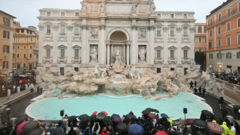The Trevi Fountain, a magnificent baroque structure located in Rome, has officially reopened after an extensive three-month restoration. This landmark, crafted in the 18th Century by renowned architect Nicola Salvi and positioned on the façade of the Poli Palace, is renowned for attracting a staggering number of visitors—previously seeing up to 12,000 tourists daily.
In a bid to preserve the fountain’s allure while improving visitor experience, a new queuing system has been implemented to limit the number of people congregating at this famous site. Mayor of Rome, Roberto Gualtieri, emphasized that the new measures would promote a more enjoyable atmosphere at the fountain, free from excessive crowding and chaos.
In addition to crowd control, city officials are also contemplating the introduction of a modest entry fee to sustain the fountain’s maintenance costs. The reopening ceremony was marked by intermittent rain but was still attended by hundreds of visitors, many of whom participated in the time-honored tradition of tossing a coin into the fountain for good luck.
The restoration largely focused on cleaning efforts that eradicated mold and calcium deposits that had accumulated over the years. This delicate process was vital as the fountain had displayed signs of deterioration by 2012, with debris observed falling from its ornate cornice due to harsh winter conditions. Following the restoration, the city is optimistic that both the Trevi Fountain and other vital landmarks will be presented in pristine condition ahead of the jubilee festivities set to begin on Christmas Eve.
Historically, the fountain serves as a terminal point for one of the ancient aqueducts that supplied water to Rome, known as Acqua Vergine, which extends for approximately 20 kilometers (12 miles). A popular myth surrounding the fountain tells of its water source being discovered by thirsty Roman soldiers led to the site by a young virgin in 19 BC, contributing to the fountain's legendary status. The tradition of tossing coins into its waters, bolstered by the classic film "Three Coins in the Fountain," has led to the collection of about €10,000 weekly, with funds directed toward charities assisting the impoverished.
In a bid to preserve the fountain’s allure while improving visitor experience, a new queuing system has been implemented to limit the number of people congregating at this famous site. Mayor of Rome, Roberto Gualtieri, emphasized that the new measures would promote a more enjoyable atmosphere at the fountain, free from excessive crowding and chaos.
In addition to crowd control, city officials are also contemplating the introduction of a modest entry fee to sustain the fountain’s maintenance costs. The reopening ceremony was marked by intermittent rain but was still attended by hundreds of visitors, many of whom participated in the time-honored tradition of tossing a coin into the fountain for good luck.
The restoration largely focused on cleaning efforts that eradicated mold and calcium deposits that had accumulated over the years. This delicate process was vital as the fountain had displayed signs of deterioration by 2012, with debris observed falling from its ornate cornice due to harsh winter conditions. Following the restoration, the city is optimistic that both the Trevi Fountain and other vital landmarks will be presented in pristine condition ahead of the jubilee festivities set to begin on Christmas Eve.
Historically, the fountain serves as a terminal point for one of the ancient aqueducts that supplied water to Rome, known as Acqua Vergine, which extends for approximately 20 kilometers (12 miles). A popular myth surrounding the fountain tells of its water source being discovered by thirsty Roman soldiers led to the site by a young virgin in 19 BC, contributing to the fountain's legendary status. The tradition of tossing coins into its waters, bolstered by the classic film "Three Coins in the Fountain," has led to the collection of about €10,000 weekly, with funds directed toward charities assisting the impoverished.


















